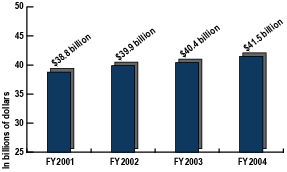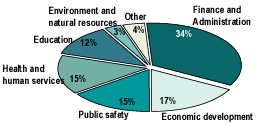The best is yet to come

Although state and local spending on information technology has slowed dramatically during the past year, the market is expected to make a full recovery over the next few years, according to the market research firm Federal Sources Inc.
Although state and local spending on information technology has slowed dramatically during the past year, the market is expected to make a full recovery over the next few years, according to the market research firm Federal Sources Inc. State and local governments will be in a mode of cautionary spending over the next several years but will return to more normal spending patterns by 2004-05, according to the McLean, Va.-based firm."This year will be challenging, but over the long term, [state and local government] is an attractive market," said Jim Kane, FSI's president and chief executive officer, at FSI's 8th annual State of the States conference held March 18 in Washington.The annual growth rate from 2001 to 2004 is 2.3 percent for the state and local IT market, FSI said. Spending for state and local IT will increase from $39.9 billion in 2002 to $41.5 billion in 2004.The market's volatility ? a result of state budget problems and the increased costs associated with homeland security ? has made it difficult to predict its growth rate with precision.In stark contrast to FSI's conservative estimates, Gartner Dataquest of Stamford, Conn., is estimating an annual growth rate of 8.2 percent from 2002 to 2005. Despite these optimistic numbers, there is no denying the market experienced "a major external shock" in 2001-02, said Rishi Sood, a principal analyst at Gartner Dataquest. This year IT companies can find new state and local opportunities in what Kane called the homeland security "vertical" comprising law enforcement, public health and public safety. As the market recovers, companies should make an extra effort to strengthen business ties with customers and align their business strategies with new trends if they want to retain their market position, Kane said.Costis Toregas, president of Public Technology Inc. of Washington, a nonprofit organization that provides cities and counties with technology guidance and support, said there are huge opportunities for IT at the local level this year, including e-government, geographic information systems and public safety communications. Toregas also said local governments increasingly will be using IT to enhance the protection of critical infrastructures such as telecommunication, transportation and utilities within their jurisdictions.Integrators that are marketing to local governments also should be looking this year for opportunities with what Toregas called "cross-boundary opportunities," which arise when counties form consortiums to leverage their buying power. While this is already happening in the human services area, it might also happen in other areas, he said. "There will be opportunities for multiple-client projects that might not be done through the competitive process," Toregas said.Some companies are already using this approach. For example, DynTek Inc., Irvine, Calif., is looking to take a bioterrorism alert system deployed in Boston and market it to other local governments. "We're looking to leverage experience gained through the development and deployment of the alert system and offer similar services to other governments and institutions, either in individual deals or through consortiums," Holli Ploog, DynTek's senior vice president of corporate development, told Washington Technology.With at least 42 states facing budget shortfalls totaling $40 billion, integrators that want to sell effectively to states must help their customers develop a strong business case for projects to generate support and funding from elected officials and state legislatures, said speakers at the FSI conference. Toregas said when local governments that had invested heavily in e-government before Sept. 11 suddenly stopped their initiatives because of security concerns, elected officials were baffled and urged them to continue. Those e-gov initiatives created an atmosphere for discussion of new IT products and solutions, Toregas said.Gregory Jackson, Ohio's chief information officer, said contractors can help him develop "value statements" that outline the tangible benefits of their products to state government and citizens so that CIOs can persuade legislatures to fund IT projects. FSI has noticed significant changes in state and local buying patterns, Kane said. For example, states are issuing fewer large requests for proposals in favor of a variety of purchasing vehicles, also known as convenience vehicles, that include schedule awards, blanket purchase agreements and agencywide or statewide contracts, he said.Even the big states where large RFPs traditionally abound are now moving away from them whenever possible. For instance, because of a string of failures with large IT projects, California abandoned that approach when it came to e-government projects. Instead, the state is using several small, inexpensive fixed-price projects, each under $500,000, that could be deployed in less than 120 days, said Arun Baheti, California's e-government director.State CIOs told industry officials they want to see more collaboration among contractors from the proposal stage through project implementation. Rather than state officials uniting companies on a project, contractors should be aware of what other companies have to offer and invite them to participate in the project, they said. "I want vendors to show they recognize that someone other than themselves has something to offer on a project and bring them to the table," said James Dillon, New York's CIO.XXXSPLITXXX-Estimated state and local government information technology spendingServices will account for 30 percent of total IT spending in fiscal 2003; FSI projects that this area will see the strongest growth between fiscal 2003 and 2004. State priorities by line item

Staff Writer William Welsh can be reached at wwelsh@postnewsweektech.com.State and local market size and forEcast

State and local FY2003 IT spending

FY2003 state budget initiatives


"I want vendors to show they recognize that someone other than themselves has something to offer on a project and bring them to the table." | James Dillon, New York's CIO
Staff Writer William Welsh can be reached at wwelsh@postnewsweektech.com.State and local market size and forEcast

State and local FY2003 IT spending

FY2003 state budget initiatives

NEXT STORY: Opportunity Knocking